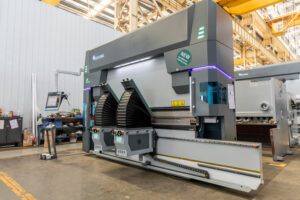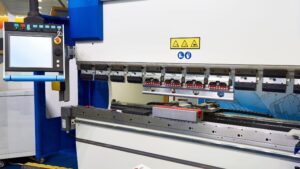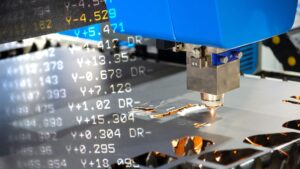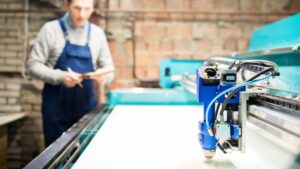Metal laser cutting is a highly versatile and precise method widely used in various industries for cutting a range of materials, from carbon steel to aluminum. One of its notable applications is cutting stainless steel, a sturdy and corrosion-resistant material known for its diverse uses in manufacturing. This guide will delve into the specifics of laser cutting stainless steel, the types of lasers used, the process, parameters, industry applications, and much more.
Can stainless steel be cut with a laser?
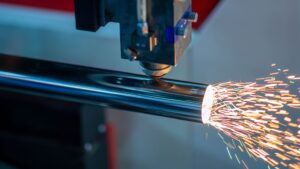
Yes, stainless steel can indeed be cut with a laser. The high intensity and precise nature of laser beams make it possible to cut stainless steel cleanly and accurately. The application of this technology has revolutionized the stainless steel manufacturing and processing industries, enhancing productivity and improving the quality of products.
How does stainless steel laser cutting work?
Stainless steel laser cutting is a process that involves several key stages:
- Design Creation: The first step is creating the design that needs to be cut. This is usually done with CAD software, which allows for high-precision designs.
- Setting Up the Machine: The design is then loaded onto the laser cutting machine. The machine settings are adjusted based on the specific requirements of the cut, such as the thickness of the steel and the desired finish.
- Laser Cutting: The laser cutting process starts. The laser cuts through the stainless steel along the programmed path, with high accuracy and speed.
- Part Extraction and Cleaning: After cutting, the finished parts are removed and cleaned. Any residual dross or debris is cleared away to reveal a clean, precise cut.
What are the different types of laser cutters used for stainless steel cutting?
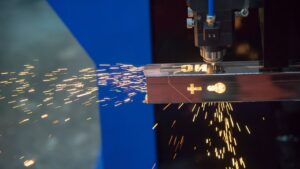
The lasers that can effectively cut stainless steel are fiber and CO2 lasers. Here are the pros and cons for each one:
Fiber laser cutters
Fiber laser cutting produces much narrower beams — typically half the diameter of the cutter ‘dot’ of a CO2 laser. This results in about quadruple the effective power for the same laser output energy.
Pros:
- Fiber lasers can process faster and with greater precision due to their narrower beam.
- The operating costs for fiber lasers are lower due to their electrical efficiency (4 to 6 times better than for CO2 devices) and solid-state construction.
Cons:
- Fiber lasers require more nitrogen shielding gas in the cutting process.
CO2 laser cutters
CO2 laser cutting typically delivers a 600-µm cutter beam width. These lasers are capable of much higher device power than fiber lasers, though modern fiber lasers are gaining ground in that regard.
Pros:
- CO2 lasers are better suited to lower-precision cuts on thicker parts.
- The capital expenditure (CAPEX) cost of equipment is considerably lower than for fiber laser machines.
Cons:
- The operating expenditure (OPEX) costs per length of cut are higher for CO2 lasers compared to fiber lasers.
What are main parameters of laser cutting stainless steel?
Cutting stainless steel with a laser involves consideration of several parameters to ensure a quality result. Let’s explore some important ones:
What are the cutting tolerances for stainless steel laser cutting?
The exact numbers for cutting tolerances can vary based on specific machines and setups, but on average you can expect:
- Kerf Width: The kerf width is the cut width made by the laser. In laser cutting, the kerf is typically very small, often less than 1 mm.
- Dimensional Tolerance: The dimensional tolerance is the allowable variance in the dimensions of the cut piece. The average cutting tolerance is typically around +/- .005″.
- Positioning Tolerance: This refers to the precision with which the laser cutter can position the cut. With modern laser cutters, this is usually very high.
What is the thickest steel that can be laser cut?
The thickest steel that can be cut with a laser varies with the type of laser and its power. With high-powered CO2 lasers, it is common to be able to cut steel up to 1 inch (25.4 mm) thick, while fiber lasers may be able to cut steel up to 1.2 inches (30 mm) thick or possibly even more. However, as thickness increases, the cut quality and speed may decrease.
What are the types of stainless steel suitable for laser cutting?
Different types of stainless steel have varying compositions, which can affect their suitability and behavior when laser cut. Below are some commonly laser-cut stainless steels:
Austenitic Stainless Steels:
- 304 Stainless Steel: This is one of the most frequently used stainless steels, known for its corrosion resistance and weldability. Its primary alloying elements are chromium (18%) and nickel (8%).
- 304L Stainless Steel: Similar to 304 but with lower carbon content to increase weldability and reduce the risk of weld decay.
- 316 Stainless Steel: Contains additional molybdenum, providing increased resistance to corrosion compared to 304, especially in chloride environments. Useful in industries such as marine and chemical processing.
- 316L Stainless Steel: Lower carbon version of 316, providing increased weldability.
- 321 Stainless Steel: Similar to 304 but contains titanium, which increases heat resistance and is useful for high-temperature applications.
- 347 Stainless Steel: Features higher resistance to high-temperature oxidation than 321, thanks to the addition of tantalum and niobium.
Ferritic Stainless Steels:
- 409 Stainless Steel: Known for its heat resistance and is often used in automotive exhaust systems. It features lower chromium content and is one of the least expensive stainless steels.
- 410 Stainless Steel: It is hardenable by heat treatment and is used in applications requiring moderate corrosion resistance.
- 430 Stainless Steel: Known for its good corrosion resistance and formability, coupled with practical mechanical properties. Used in automotive trim and appliance components.
Martensitic Stainless Steels:
- 410 Stainless Steel: A hardenable stainless steel commonly used for applications requiring high strength and moderate corrosion resistance.
- 420 Stainless Steel: Known for its higher carbon content, lending it excellent hardness and strength.
- 440C Stainless Steel: Offers the highest hardness of any type of stainless steel, making it suitable for applications requiring high wear resistance.
Duplex Stainless Steels:
- 2205 Duplex Stainless Steel: Combines many of the beneficial properties of ferritic and austenitic steels. Known for its high resistance to stress corrosion cracking and high strength.
- 2507 Super Duplex Stainless Steel: Possesses very high resistance to pitting, crevice, and general corrosion. It also provides excellent mechanical properties and low thermal expansion.
What is the best stainless steel for laser cutting?
The “best” stainless steel for laser cutting can depend on the specific application and requirements. However, austenitic stainless steels, like 304 and 316, are often chosen for their good cuttability, availability, and corrosion resistance.
What are the industries that utilize laser cutting for stainless steel?
Laser cutting for stainless steel finds applications across various industries. Some of them include:
- Automotive manufacturing
- Aerospace industry
- Medical device manufacturing
- Jewelry making
- Food and beverage equipment production
- Construction and architecture
These industries leverage the precision, efficiency, and versatility of laser cutting to create parts and components from stainless steel.
What Are the Expected Outcomes of Using a Laser for Cutting Stainless Steel?
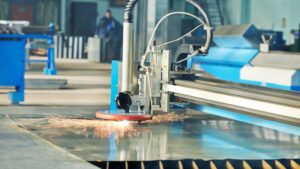
Laser cutting of stainless steel can be extremely precise, producing clean edges with minimal heat damage. This is particularly true when all the settings are optimized. A gas-assist setup is crucial to keep the laser’s path free of debris, helping to ensure a cleaner cut. However, the process is not without potential challenges. Certain common faults can occur, but once identified, they can be corrected:
- Large, Irregular Dripping at the Lower Face on Both Sides of the Cut: This indicates the cutter is running too hot. To correct this, increase the feed rate for reduced local heat, increase air assist for cooling, or raise the focal point slightly higher above the cut.
- Large, Irregular Dripping at the Lower Face, One side of the Cut: This could be due to similar issues as dripping on both sides, but it is usually caused by an air assist nozzle that is not centered properly.
- Small Drips at the Lower Edge of the Cut: The focal point may be too low or the feed rate too high.
- Upwards Splashing of Melt is Visible: This often indicates that the feed rate is too high, and in some cases, the air assist may be too aggressive.
- Yellow or Brown Staining at the Cut: This might mean that the nitrogen feed is too low or that the nitrogen has been contaminated with oxygen.
What Are Important Things to Consider When Laser Cutting Stainless Steel?
Laser cutting stainless steel requires a careful consideration of several factors to ensure optimal results:
- Correct Power Settings: Setting the laser at the right power level is crucial to achieve clean cuts and avoid damaging the material.
- Focal Point Position: The position of the focal point can significantly influence the quality of the cut. It’s important to adjust it correctly based on the thickness and type of stainless steel being cut.
- Choice of Assist Gas: The choice between oxygen, nitrogen, or air can influence the quality of the cut, the edge condition, and the cutting speed.
- Material Thickness: The thickness of the material can affect the cutting speed and quality. In general, thinner materials can be cut faster and more precisely than thicker ones.
- Laser Cutting Speed: The speed at which the laser cuts the material can impact the cut quality. Too slow, and the material could be damaged by excess heat; too fast, and the cut may not be clean.
Some common mistakes to avoid when laser cutting stainless steel include not properly maintaining the machine, not optimizing settings for different material types and thicknesses, and not regularly inspecting cut quality and making necessary adjustments.
How to Laser Cut Stainless Steels?
The process of laser cutting stainless steel involves several steps:
- Material Preparation: First, prepare the stainless steel sheet by cleaning it to remove any dirt or oils that might interfere with the cutting process.
- Machine Setup: Configure the laser cutting machine according to the type and thickness of the stainless steel. This includes setting the appropriate power level and cutting speed.
- Focusing the Laser: Adjust the laser’s focal point for the specific thickness of the material.
- Cutting Process: Initiate the cutting process. The laser beam will follow the path defined in the digital design, cutting through the stainless steel sheet.
- Post-Cutting Operations: After cutting, the edges of the cut stainless steel may need to be cleaned or deburred.
Is Laser Cutting Stainless Steel Expensive?
The cost of laser cutting stainless steel can vary significantly depending on the complexity of the design, the thickness of the material, and the type of laser used. On average, you can expect prices to range from $1 to $5 per linear inch for thin gauge stainless steel.
Which are the Best Stainless Steel Laser Cutting Machines?
Choosing the right laser cutting machine can make all the difference in your stainless steel cutting project. A quality laser cutter should possess these characteristics:
- Precision: The machine should deliver highly precise cuts, maintaining the dimensional accuracy of the design.
- Speed: High cutting speed without sacrificing quality is crucial for productivity.
- Power: The machine should have sufficient power to handle the type and thickness of stainless steel you plan to cut.
- Reliability: Look for a machine with a reputation for reliable, consistent performance.
- Ease of use: User-friendly interface and software make it easier to manage cutting tasks.
- Maintenance: Lower maintenance costs and easier maintenance routines are definitely an advantage.
One recommended series of machines for laser cutting stainless steel are Accurl fiber laser cutters. These include:
- Smart 1kW 1.5kW 2kW 3kW Fiber Laser Machines: Engineered for speed and flexibility, the ACCURL Smart small laser cutting machine is ideal for ultra-high-speed cutting of thin sheet metal parts and similar materials. This machine increases productivity and reduces operating costs.
- SmartLINE 2kW-4kW Fiber Laser Machines: The ACCURL® SmartLINE is packed with easy-to-use features and offers undisputed efficiency and superior quality results. It is versatile, suitable for a wide range of materials used in metal fabrication, including highly-reflective metals and thick mild steel.
- MasterLINE 6kW-15kW Fiber Laser Machines: ACCURL® MasterLINE machines are the most complete, compact, and configurable sheet metal laser cutter systems on the market. These machines are designed to evolve with your needs. MasterLINE fiber lasers are suitable for a wide range of materials, including highly-reflective metals and high thickness mild steel.
What are Alternative Technologies and Machines for Laser Cutting Stainless Steel?
Laser cutting isn’t the only technology available for cutting stainless steel. There are alternatives, each with its pros and cons:
- Waterjet Cutting: This uses a high-pressure jet of water or a mixture of water and an abrasive substance to cut through the material. It’s a versatile process that can cut a wide range of materials, but it’s slower and more expensive than laser cutting.
- Plasma Cutting: Plasma cutting uses an accelerated jet of hot plasma to cut through electrically conductive materials. It’s faster than waterjet and laser cutting for thicker materials but may not deliver the same level of precision.
- Mechanical Cutting (e.g., Shearing, Sawing, Punching): These methods can be less expensive than laser cutting for simpler, less precise jobs, but they don’t offer the same versatility or precision.
In general, laser cutting provides the best balance of speed, precision, and versatility for most stainless steel cutting tasks, especially for thinner materials or complex designs.
Conclusion
Laser cutting stainless steel is an advanced and efficient method offering numerous advantages, such as high precision, speed, and versatility. It allows for complex designs and smooth finishes, making it an ideal choice for various industries including automotive, aerospace, medical, and many more. However, it is essential to have a clear understanding of the laser cutting process, the types of lasers used, the various types of stainless steel, and the potential issues that may arise during the process.
he choice between CO2 and fiber lasers will largely depend on the specific requirements of the job. While CO2 lasers are generally less expensive and better for thicker materials, fiber lasers are more precise and energy-efficient, which can lead to lower operating costs over time.
By understanding these factors and leveraging the power of advanced laser cutting machines, such as those offered by Accurl, it’s possible to achieve superior results in stainless steel laser cutting.
FAQs
1. What Gas is Used for Laser Cutting Stainless Steel?
When cutting stainless steel, nitrogen is commonly used as an assist gas because it provides a clean cut edge and prevents oxidation. However, other gases like oxygen or compressed air may be used for different cutting effects or cost considerations.
2. Can a 10W Laser Cut Stainless Steel?
A 10W laser is generally not powerful enough to cut stainless steel. Cutting stainless steel typically requires a more powerful laser in the range of kilowatts.
3. Does CO2 or Fiber Laser Cut Stainless Steel Better?
Both types of lasers have their advantages. Fiber lasers are generally more efficient, provide a more focused beam for high precision cutting, and are better suited for cutting thinner materials. CO2 lasers, on the other hand, are capable of cutting thicker materials and can be less expensive upfront, but may have higher operating costs.


